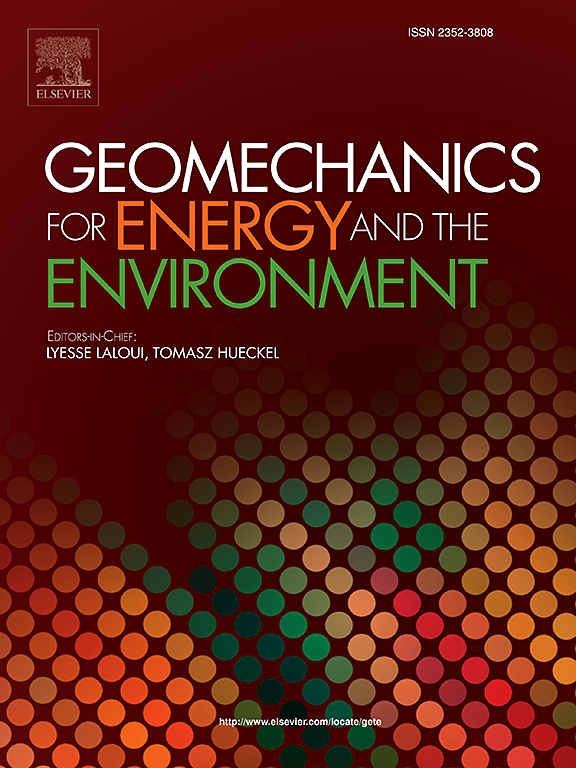An evaluation method of hydraulic fracture propagation behavior in rock containing natural fractures based on fractal dimension
IF 3.3
2区 工程技术
Q3 ENERGY & FUELS
引用次数: 0
Abstract
This study presents a novel method for quantifying the propagation of hydraulic fractures and their interaction with natural fractures under varying fracturing conditions. We examine the impact of approach angle, fracture aperture, borehole distance, differential stress, and injection rate on hydraulic fracture behaviour using the Particle Flow Code 2D (PFC2D) model. The results reveal two main fracture extension modes: crossing and retained. The approach angle significantly affects the fractal dimension of hydraulic fractures, with peak values of 1.12 at intermediate angles (30°–60°) and lower values (0.96–0.98) at extreme angles (0° and 90°). Increasing fracture aperture accelerates propagation by 13.7 %, while a higher injection rate raises the fractal dimension by 22.6 %. Borehole distance introduces variability, and as differential stress increases, the fractal dimension increases from 0.98 to 1.17, accompanied by a 43.4 % increase in breakdown pressure. To model temporal variations in fractal dimensions, The Logistic method adjusts the fractal dimension amplitude with parameter and controls the growth rate during the acceleration phase with . The BiDoseResp method, by contrast, modulates amplitude using and , and regulates the entry and exit stages through and . Parameters , , and govern amplitude and growth during the retention and acceleration phases. These models provide a framework for optimising hydraulic fracturing in geothermal development, enhancing fracture dynamics understanding and improving resource extraction efficiency.
基于分形维数的含天然裂缝岩石水力裂缝扩展特性评价方法
该研究提出了一种量化水力裂缝扩展及其在不同压裂条件下与天然裂缝相互作用的新方法。我们使用颗粒流代码2D (PFC2D)模型研究了接近角、裂缝孔径、井眼距离、差应力和注入速率对水力裂缝行为的影响。结果表明,裂缝扩展主要有两种模式:交叉扩展模式和保留扩展模式。接近角对水力裂缝分形维数影响显著,中间角(30°~ 60°)峰值为1.12,极端角(0°和90°)较低(0.96 ~ 0.98)。增大裂缝孔径可使裂缝扩展加速13.7 %,增大注入速率可使裂缝分形维数提高22.6% %。井距引入了变异性,随着差应力的增大,分形维数从0.98增加到1.17,击穿压力增加43.4% %。为了模拟分形维数的时间变化,Logistic方法用参数A2来调节分形维数的幅度,用参数p1来控制加速阶段的增长速度。相比之下,BiDoseResp方法通过A3和A4调节振幅,并通过LoGt1和LoGt2调节进入和退出阶段。参数h1、h2和p2控制了保持和加速阶段的振幅和生长。这些模型为地热开发中的水力压裂优化提供了框架,增强了对裂缝动力学的理解,提高了资源开采效率。
本文章由计算机程序翻译,如有差异,请以英文原文为准。
求助全文
约1分钟内获得全文
求助全文
来源期刊

Geomechanics for Energy and the Environment
Earth and Planetary Sciences-Geotechnical Engineering and Engineering Geology
CiteScore
5.90
自引率
11.80%
发文量
87
期刊介绍:
The aim of the Journal is to publish research results of the highest quality and of lasting importance on the subject of geomechanics, with the focus on applications to geological energy production and storage, and the interaction of soils and rocks with the natural and engineered environment. Special attention is given to concepts and developments of new energy geotechnologies that comprise intrinsic mechanisms protecting the environment against a potential engineering induced damage, hence warranting sustainable usage of energy resources.
The scope of the journal is broad, including fundamental concepts in geomechanics and mechanics of porous media, the experiments and analysis of novel phenomena and applications. Of special interest are issues resulting from coupling of particular physics, chemistry and biology of external forcings, as well as of pore fluid/gas and minerals to the solid mechanics of the medium skeleton and pore fluid mechanics. The multi-scale and inter-scale interactions between the phenomena and the behavior representations are also of particular interest. Contributions to general theoretical approach to these issues, but of potential reference to geomechanics in its context of energy and the environment are also most welcome.
 求助内容:
求助内容: 应助结果提醒方式:
应助结果提醒方式:


